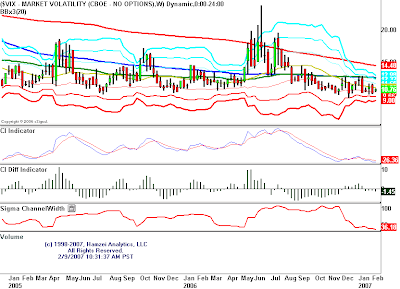Risk Aversion Behavior
Sally Limantour
The biggest news today is the 9% collapse in China’s share prices. The People’s Bank of China’s decision to raise the discount rate one more time in the day prior to the Lunar New Year is piercing the bubble in what is the largest sell off in more than a decade.
We are coming into the market with this spreading globally and the S&P down .93% and the NQ down 1.66%. The mini S&P just went through the support level I mentioned on my 12/23/07 update of 1440.00. We also had a very weak durable goods number this morning coupled with the Greenspan “R” word in our collective psyche’s, the sub prime worries and geopolitical concerns.
Earlier this month Mr. Cheng Siwei, the Vice Chairman of the National People’s Congress, said the speculative rise in share prices was a “bubble” and that investors need to be concerned about the risks in the stock market.
In the FT he said, “In a bull market people will invest relatively irrationally. Every investor thinks they can win. But many will end up losing.That is their risk and their choice.” The question on everyone’s mind this morning is whether the liquidity spigot will turn to a slow drip as huge capital inflows from China has allowed excess capital to move globally propping up stock markets everywhere. Or… to we do what has been working for so long which is to buy the breaks.
This morning has the taste of fear and liquidation. My first good support in ESH7 comes in at 1229.50. As mentioned yesterday, after having my shortest term model on a sell for a week, it went back to long and many people emailed asking how to I use this model. I use it for day trading only- no overnight positions in this timeframe. If it is flashing a sell, I tend to be more aggressive on selling during the day. If it is in a buy mode, I will more actively pursue the long side on breaks which is what I did yesterday. All last week, starting on Friday Feb 16th, the sell signal was predominant so my strategy was to sell rallies until yesterday. Coming in today on this short term model I am flat and it has turned back to the sell mode.
This does not mean to come in and sell the ESH7 at the open, but to watch and see if there will be any good intraday opportunities to go short. Obviously as a day trader I may pursue the long side on a sharp spike down to that 1429.00 area, but will see how the day unfolds.
Given the current risk aversion playing out across global equity markets coupled with my medium term indicators warning of a high probability of risk aversion behavior this is not a time to be buying dips aggressively and holding in my opinion. We have had a one way market for most global equities since June/July 2006 and the cracks are starting to appear.
Long volatility positions in the stock indices mentioned weeks ago were established as a way to capture a potential wave of risk aversion for the next few months.
Going forward should this turn into a more meaningful sell off we have to assess how this will carry into other asset classes that have benefited from
this global infusion of capital, such as the commodity sector. The metals are taking a hit from this as is the dollar. Bonds, however are benefiting from this and exhibiting the flight to quality behavior as we approach key resistance levels in the June bonds of 112.20-113.00. Currently, I am holding off on short positions in bonds and tightening stops on most commodity long positions.

 Action: continue to sell rallies in the bond market
Action: continue to sell rallies in the bond market The main threats going forward in the near term would be interest rate/inflation fears, geopolitical concerns (Iran jitters and another ship sent in yesterday) and anxiety towards the sub prime lending resurfacing after Lloyd’s TSB’s badly received figures. Rising oil prices too are on our radar.
The main threats going forward in the near term would be interest rate/inflation fears, geopolitical concerns (Iran jitters and another ship sent in yesterday) and anxiety towards the sub prime lending resurfacing after Lloyd’s TSB’s badly received figures. Rising oil prices too are on our radar.
























































